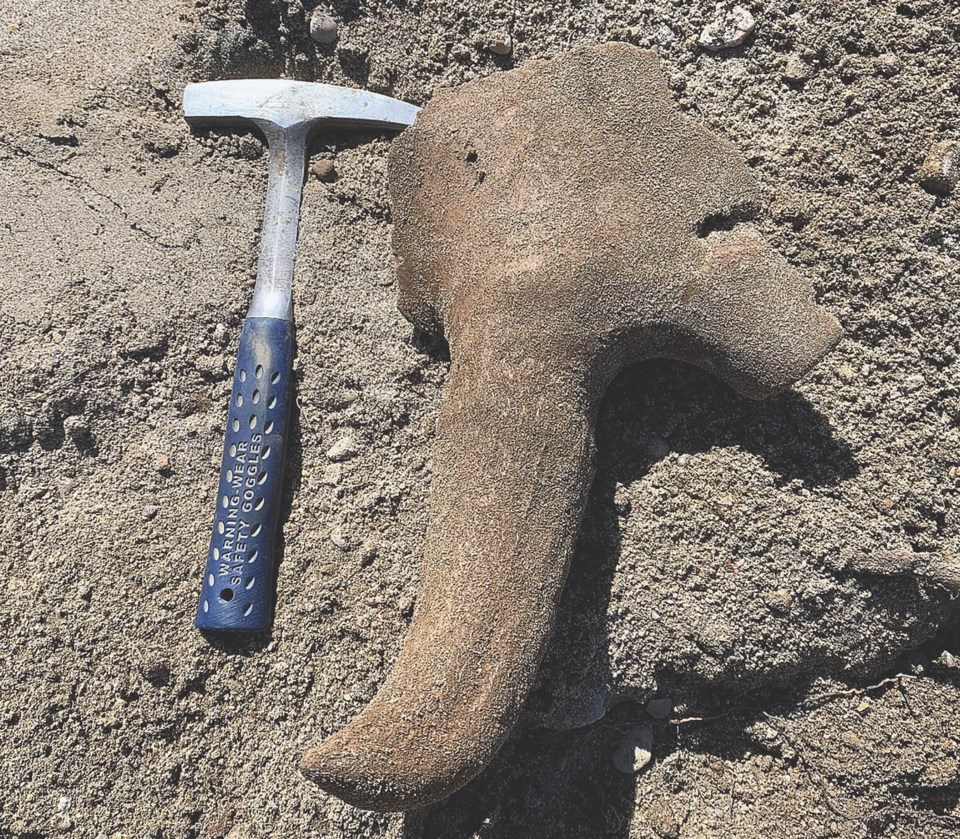ATHABASCA – A local heavy equipment operator made the find of a lifetime when he spotted a horn core from an Ice Age bison during recent excavation for the bridge project that will cross the Athabasca River.
Rory Couturier won’t be able to keep the fossil that he found May 16, but it does represent a significant find for the region, says paleontologist Dr. Paul McNeil as there have only been four or five similar finds along the Athabasca River.
“In terms of northeastern Alberta, these fossils are extremely rare. In the research we did beforehand, we found that there were only four or five known Ice Age mammal fossils that had been found along the Athabasca River. Not only are they rare, but there isn’t a lot of development in the area, so there’s less chance to find them as they’re excavated,” said Dr.McNeil.
It might seem like finding a needle in a haystack, but according to Dr. McNeil, who runs Steppe Consulting Inc., there were some signs that told them what they needed to look out for.
“In this case, it started with the design of the bridge as it has to get a historical resource permit. Any big project in Alberta has to be cleared for historical resources, be it archaeology or paleontology,” said Dr. McNeil, who did his doctoral work at the University of Calgary. “At that stage, we did a pre-construction visit to analyze the site, and realized the potential for finding Ice Age fossils in the deposits above the Athabasca River.”
Dr. McNeil has been on site monitoring the construction as they plowed through the gravel layers, although the prework didn’t guarantee they would find anything. But once it was found, the fossil caused quite a stir locally.
“I think it’s great that the find generated as much interest as it did,” said Dr. McNeil, noting Couturier’s Facebook post on the find garnered over 200 shares and 50-plus comments. “The more people that are out there that know what we do, the more chance there is that fossils can be found, and made public.”
Due to the nature of the find, Dr. McNeil says that the isolation of the bone isn’t unusual as Ice Age fossils found alongside rivers are often “disarticulated” over the millennia and end up being deposited in the riverbank bit by bit.
“Once it was found, the horn core is by itself, so after it’s collected there’s not much more to it. We take the GPS coordinates, we document it, we take the geological information and describe it. It’ll go to the Royal Tyrrell Museum, where it’ll be catalogued, and then finally it goes to the Royal Alberta Museum in Edmonton, which is the repository for our Ice Age mammal fossils.”
Its exact age has yet to be confirmed as scientists will use a process called radiocarbon dating to confirm its age down the road, although Dr. McNeil thinks it’s around 11,000 years old, in part due to a prior find in the gravel pit.
And if he’s correct, it would mean that the sample is from an evolutionary predecessor to the modern-day bison; the two predominant species at that time were bigger, so despite the fact that the bison horn is a juvenile, its horn is still larger than what we would see today.
“This is our record, and our history. It’s an indication of what life in Alberta was like before we were here. In this case, we had a time where we were undergoing rapid climate change, where glaciers were retreating, creating a whole different type of ecosystem,” said Dr. McNeil.
“We can see the animals that lived there, how they reacted to these changes. We can’t do it in real time, so these give us an indication of how it happened in the past.”




